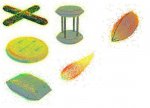Hello folks,
Sorry about the long post!
I have a bit of a project on the go which has to be finished by April. We've set our sights quite high considering the lack of experience we have, but there are 5 of us working on it so hopefully we'll get there.
Quick overview of the project:
I'm sure most of you know what an ROV is. Our project is a model AUV - Automated Underwater Vehicle, for which the ultimate goal (in industry) is a vehicle capable of navigating to a predesignated area and performing some task (i.e. actuate a valve on a christmas tree). The image recognition capabilities on the more advanced models using cutting edge software, and given we have a budget of £500, we're going to be downsizing quite a bit.
The emphasis of our project is stability, which we are investigating on two fronts. The first is an efficient hull design, to minimize drag force due to underwater currents. The second is by way of a stability system - which I am working on.
I've had a look online to see how feasible a system we can develop, done a bit of thinking and would be delighted if you chaps could help steer me in the right direction. I've looked into AUVs and 'drones' for the stability - essentially a similar idea but in water not air.
Ideally the AUV would navigate a predetermined path and then when it reached it's 'destination' it would try it's best to stay in that position.
Ultimately, I'd like to incorporate the following for navigation.
-Ultrasound transceiver on the front face of the AUV, to gauge distance from 'target'.
-Pressure Sensor / Barometer - to gauge depth.
I realise this would only give position in 2 directions, but sticking to the idea that this is on the sea bed, that's a realistic assumption.
For stability, I'd like to use a 6 Axis Accelerometer. I had a look online, and I was wondering if something like this would be suitable for use with the PICAXE:
http://www.robotshop.com/sfe-6dof-razor-ultra-thin-imu-triple-axis-3g-accelerometer.html
Having had a quick read on a few threads on the forum, am I right that the correct way to actuate a response from an accelerometer is in integrating the acceleration twice to get the displacement, and actuating an appropriate response to counter this?
For actuation, I was thinking these bilge pumps would be ideal:
http://www.force4.co.uk/842/Rule--1100-Submersible-Bilge-Pump.html
Given they are waterproof already, can be manipulated fairely easily, and are fully reversible.
To sum up, I suppose I'm hoping for some general advice. Does this seem feasible using a Picaxe microcontroller?
I've bought myself a 18M2 started kit (not for this project - for myself) and a bunch of LEDs / Resistors to have a play around with so hopefully in a week or two I'll be up and running and will be asking some more technical questions!
Cheers,
Brian.
Sorry about the long post!
I have a bit of a project on the go which has to be finished by April. We've set our sights quite high considering the lack of experience we have, but there are 5 of us working on it so hopefully we'll get there.
Quick overview of the project:
I'm sure most of you know what an ROV is. Our project is a model AUV - Automated Underwater Vehicle, for which the ultimate goal (in industry) is a vehicle capable of navigating to a predesignated area and performing some task (i.e. actuate a valve on a christmas tree). The image recognition capabilities on the more advanced models using cutting edge software, and given we have a budget of £500, we're going to be downsizing quite a bit.
The emphasis of our project is stability, which we are investigating on two fronts. The first is an efficient hull design, to minimize drag force due to underwater currents. The second is by way of a stability system - which I am working on.
I've had a look online to see how feasible a system we can develop, done a bit of thinking and would be delighted if you chaps could help steer me in the right direction. I've looked into AUVs and 'drones' for the stability - essentially a similar idea but in water not air.
Ideally the AUV would navigate a predetermined path and then when it reached it's 'destination' it would try it's best to stay in that position.
Ultimately, I'd like to incorporate the following for navigation.
-Ultrasound transceiver on the front face of the AUV, to gauge distance from 'target'.
-Pressure Sensor / Barometer - to gauge depth.
I realise this would only give position in 2 directions, but sticking to the idea that this is on the sea bed, that's a realistic assumption.
For stability, I'd like to use a 6 Axis Accelerometer. I had a look online, and I was wondering if something like this would be suitable for use with the PICAXE:
http://www.robotshop.com/sfe-6dof-razor-ultra-thin-imu-triple-axis-3g-accelerometer.html
Having had a quick read on a few threads on the forum, am I right that the correct way to actuate a response from an accelerometer is in integrating the acceleration twice to get the displacement, and actuating an appropriate response to counter this?
For actuation, I was thinking these bilge pumps would be ideal:
http://www.force4.co.uk/842/Rule--1100-Submersible-Bilge-Pump.html
Given they are waterproof already, can be manipulated fairely easily, and are fully reversible.
To sum up, I suppose I'm hoping for some general advice. Does this seem feasible using a Picaxe microcontroller?
I've bought myself a 18M2 started kit (not for this project - for myself) and a bunch of LEDs / Resistors to have a play around with so hopefully in a week or two I'll be up and running and will be asking some more technical questions!
Cheers,
Brian.



